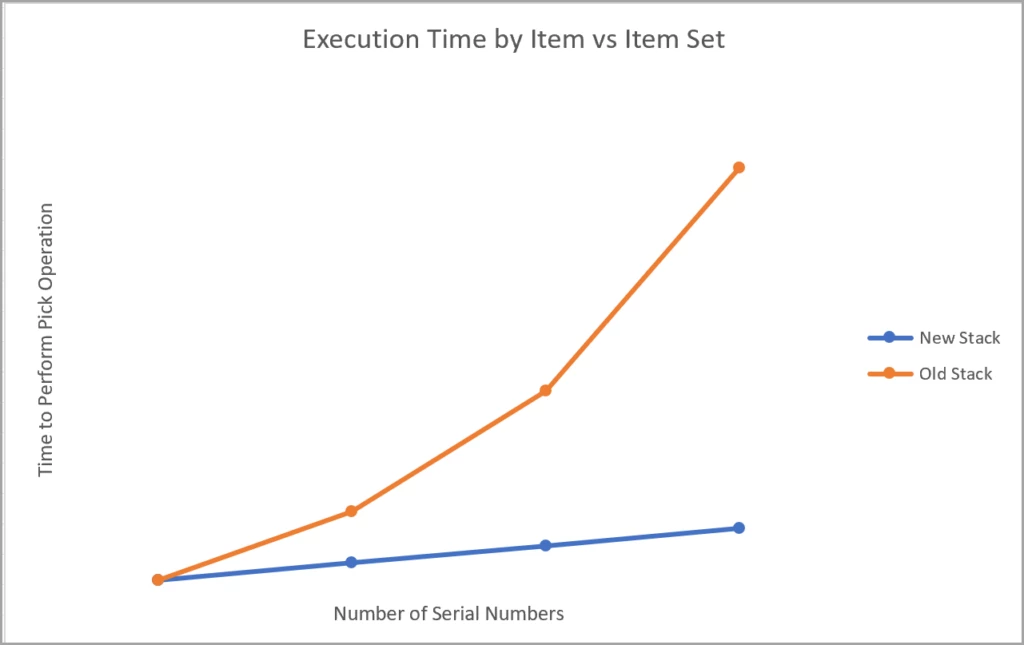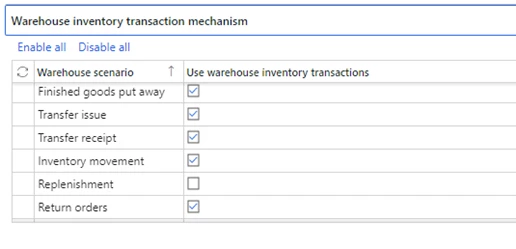
Introducing warehouse-specific inventory transactions
Microsoft Dynamics 365 Supply Chain Management release 10.0.32 introduces warehouse-specific inventory transactions. These transactions are optimized for warehouse operations, with important benefits for system performance and efficiency.
Warehouse transactions offer important advantages over inventory transactions for warehouse operations
We recommend using warehouse transactions for warehouse scenarios where they apply. Unlike inventory transactions,
- Warehouse transactions can operate on sets of items with different serial or batch numbers. Item sets can be reused, avoiding the need to record the same information multiple times.
- Warehouse transactions are only used in warehouse operations, which don’t have any financial impact. This significantly reduces the number of database fields, indexes, and validations.
Note: The system still relies on inventory transactions for warehouse operations that have a financial impact. - Warehouse transactions are archived often. This keeps the warehouse transactions table small and allows the system to implement different data models for active and completed transactions. Active transactions are optimized for inserts, critical for fast mobile device operations. Completed transactions are optimized for querying.
What motivated this change?
Inventory transactions live in the InventTrans table, the workhorse of the inventory system. Multiple Supply Chain Management modules, including the Warehouse Management System, refer to the inventory system when working with inventory transactions. Analyzing historical data, we found that on average, 30% of Warehouse Management operation execution time occurs in the inventory system. Because other modules rely on the inventory system, we can’t optimize it for warehouse needs. Instead, we created new transactions just for the warehouse system. By separating warehouse-specific inventory transactions from other inventory transactions, we’ve reduced the dependency of the warehouse system on the inventory system.
However, separating warehouse and inventory transactions was only the first steppingstone on the way to the performance improvements we wanted. The way the system worked with items was another factor that made warehouse operations less efficient. Items have specific identifiers, or tracking dimensions, like batch and serial numbers. Our analysis showed that the execution time of warehouse operations is proportional to the number of items it works with. By introducing item sets—reusable collections of items that have specific dimensions and quantities—we’ve made warehouse operations less dependent on the number of items involved.
The following chart shows the difference in sales picking work execution time for individual items with many tracking dimensions (old stack) and item sets (new stack).

What’s changing and what has stayed the same?
From the user’s perspective, not much has changed. Warehouse Management System users will notice only that there’s a new form to view warehouse-specific transactions. In the following example, a sales order picking operation, the form shows transactions related to the sales order and transactions related to the warehouse work created for that order (warehouse-specific transactions).

The inventory transaction form that users are familiar with, as in the example below, now shows only the source transaction for the sales picking work.

How to try out warehouse transactions
The new warehouse-specific inventory transactions are available for private preview with limited support for warehouse operations in release 10.0.31 of Supply Chain Management. The public preview release 10.0.32 supports all warehouse operations.

In release 10.0.32, enable Warehouse-specific inventory transactions in the Feature management workspace. Because the warehouse-specific inventory transaction feature is in private preview in release 10.0.31, you’ll need to activate the WHSWarehouseInventoryTransactionFeature flight first.
After you enable Warehouse-specific inventory transactions in either release, go to the Warehouse Management parameters page > Warehouse inventory transaction mechanism section. Select the warehouse scenarios that should use warehouse transactions, as in the following example:

Warehouse scenarios that don’t use warehouse transactions will continue to use inventory transactions.
Learn more
Read the product documentation: Warehouse-specific inventory transactions – Supply Chain Management | Dynamics 365 | Microsoft Learn
Not yet a Supply Chain Management customer? Take a guided tour!



